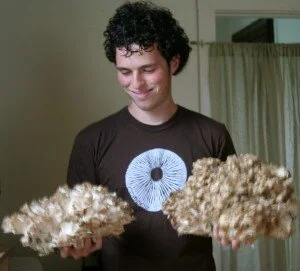Awaiting the Maitake Dance
Ari proudly holds two of last fall's maitake
The venerable maitake, or hen of the woods (Grifola frondosa), is on the horizon. While bite for bite, I must concede that the morel, porcini, and black trumpet all pack more flavor, there is nothing as satisfying and rewarding as finding a massive hen roosting on the ground at the base of a living tree or stump in the fall. Maitake, prized in Japan and China for its edible, medicinal, and nutritional properties, arrives as soon as the first of September and can be found as late as early November in the Northeast. While I most frequently see them around oak trees, they can occasionally be found near maple, elm, beech, chestnut, sycamore, and black locust. After you have discovered a patch, it will reliably come back every fall for the duration of its several year life span, assuming temperatures are not too extreme and rainfall is adequate.
Their name literally translates to “dancing mushroom” in Japanese, a fact I discovered only after my first hen spotting last autumn, when I spontaneously burst into a manic sequence of dance moves and yelps (“Yip-yip-yipeeee! Whoo-hoooh!”). If you are ever lucky enough to find a maitake, I can almost guarantee you too won’t be able to stand still! I have found single hens of the woods weighing as much as 50 pounds, and I have seen oak trees with as many as eight separate hens in a ring around the base. You’d think a fungus as big as the maitake would be easy to spot, which is only partially true. Once you have an eye for them, you can spot them even on a bicycle, which is in fact a recommended foraging method given their prevalence in the suburbs. However, to the eyes of a neophyte, maitake is heavily camouflaged, blending in with the brown leaves and bark that surround it.
Last fall, I harvested enough maitake to eat it for breakfast, lunch, and dinner, while still having plenty to give to friends. Indeed, there is nothing more satisfying than sharing the wild harvest! Friends always seem grateful, but I had a particularly memorable experience when my professional chef friend cooked me a truly unforgettable meal with a hen I had just given him. He sautéed the maitake with fresh, homemade pasta in a light cream sauce, with divine results.
At a barbeque on Cayuga Lake earlier this summer, I told the maitake chef that he would be the first to receive any of my surplus maitake this fall. How could it be any other way?
